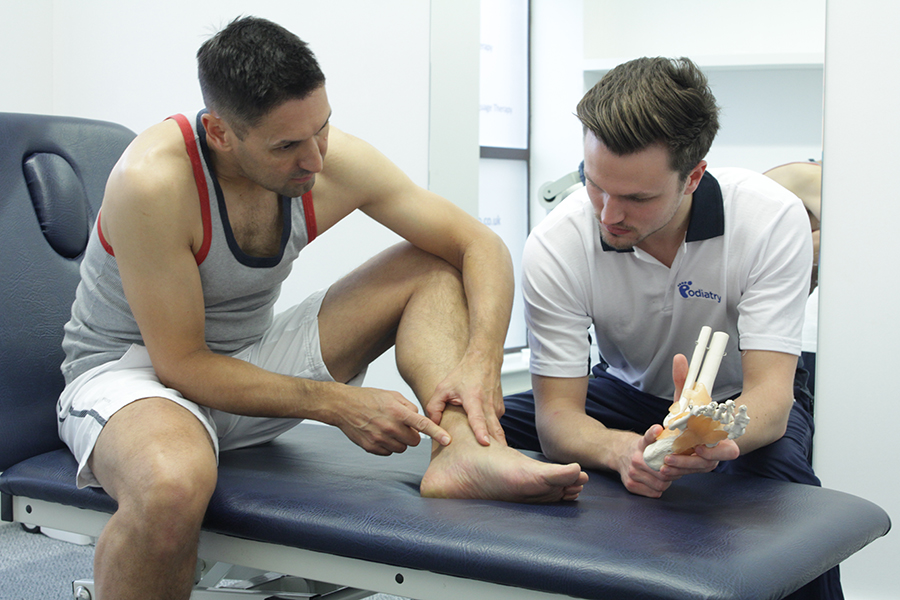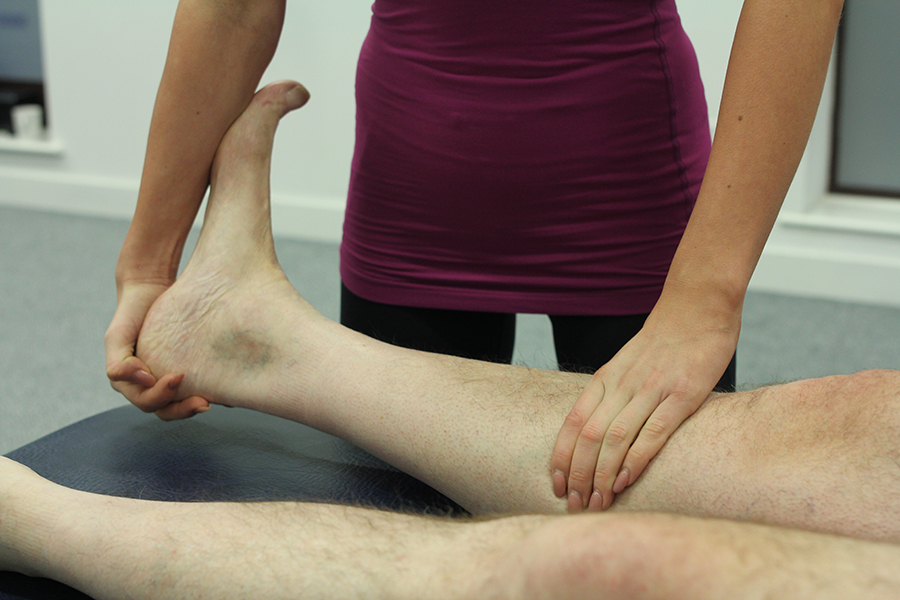Posterior impingement syndrome
Posterior impingement syndrome is a painful condition that affects the back of the ankle.
Posterior impingement syndrome can be either a soft tissue or a bony disorder that results in pain at the back of the ankle, particularly when the ankle is plantarflexed (this is the position the foot is in when the toes are pointing towards the ground). Posterior impingement syndrome is common complaint of ballet dancers.
The ankle joint, which consists of the talus (ankle bone) and the tibia (the larger of the two leg bones) is a hinge joint, this means that through overuse or through injury the soft tissues can become pinched or trapped between the two bones that form the joint ' and this causes pain.
A bony impingement occurs when the two bones that form the ankle joint 'jar' against one another. When bone jars against bone it is traumatised and the bone reacts by creating more bone in order to heal itself. The result is overgrowth of bone which forms a bony spur that inhibits movement.
Posterior ankle impingement syndrome can also be the result of an Os Trigonum; this is a small round bone at the back of the ankle present in only a few people. An Os Trigonum is present when the talus (the ankle bone) does not fuse during development. An Os Trigonum can lead to posterior impingement syndrome by getting caught between the ankle joint when the foot is plantarflexed.
Posterior impingement syndrome has a number of causes, however, the common factor in the development of the condition is overuse of the ankle joint by participating in activities that involve lots of plantarflexion of the ankle joint (this is the position the foot is in when the toes are pointing towards the ground). Alternatively posterior impingement syndrome may be the result of one single event whereby the foot is forced into plantarflexion.
When the ankle is plantarflexed the two bones which make up the ankle joint (the talus and the tibia) can trap and compress ligaments and other soft tissue, resulting in soft tissue and or bone damage. The result is pain at the back of the ankle and a decrease in movement as the ankle joint is unable to move through its normal range of movement due to the impingement which blocks it.

The main sign of posterior ankle impingement syndrome is pain at the back of the ankle that is worse when the ankle is plantarflexed (toes pointing towards the ground).
Posterior ankle impingement syndrome can be either:
Soft tissue
Soft tissue posterior ankle impingement syndrome occurs when the soft tissues that surround the ankle joint become trapped and compressed between the ankle joint during plantarflexion.
Bony
Bony posterior ankle impingement syndrome occurs when bony spurs form on the joint as the two bones that form the joint jar against one another during plantarflexion. The bony spurs can then pierce and pinch soft tissue as well as inhibit movement of the ankle joint.
Posterior ankle impingement syndrome is diagnosed based on a thorough history, the signs and symptoms and an examination of the ankle joint. It is un-necessary to have an X-ray, although an X-ray may be requested to confirm or rule out another disorder.
Podiatric benefits that can be achieved following assessment and treatment include:
Podiatry for posterior ankle impingement syndrome would involve obtaining a thorough history, which would include an account of the problem itself as well as a full medical history. Your podiatrist will then examine the ankle joint and put the foot into plantarflexion in order to recreate any symptoms.
Upon the diagnosis of posterior ankle impingement syndrome you will be given an explanation as to the cause of your condition and what can be done about it. The treatments will be outlined and a plan will be mutually devised on the best plan of action and treatment for you.
The treatments for posterior ankle impingement syndrome may include:

Posterior ankle impingement syndrome is a painful condition that affects the back of the ankle. Posterior ankle impingement syndrome occurs when the soft tissues that surround the ankle joint (the talus and the tibia) are pinched during plantarflexion, but can also be the result of bone growth (spurs) or an extra bone (called an Os Trigonum) being caught in the joint and inhibiting movement.
If you think you have posterior ankle impingement syndrome one of our podiatrists at Chiropody.co.uk can help. Our podiatrists are highly trained and will provide you with a treatment plan designed to reduce any pain and inflammation as well as increase the function of the ankle joint.
To arrange an assessment with one our podiatrists please email office@chiropody.co.uk or call 0330 088 4222.
What is posterior Impingement syndrome?
Posterior impingement syndrome can be either a soft tissue or a bony disorder that results in pain at the back of the ankle, particularly when the ankle is plantarflexed (this is the position the foot is in when the toes are pointing towards the ground). Posterior impingement syndrome is common complaint of ballet dancers.
The ankle joint, which consists of the talus (ankle bone) and the tibia (the larger of the two leg bones) is a hinge joint, this means that through overuse or through injury the soft tissues can become pinched or trapped between the two bones that form the joint ' and this causes pain.
A bony impingement occurs when the two bones that form the ankle joint 'jar' against one another. When bone jars against bone it is traumatised and the bone reacts by creating more bone in order to heal itself. The result is overgrowth of bone which forms a bony spur that inhibits movement.
Posterior ankle impingement syndrome can also be the result of an Os Trigonum; this is a small round bone at the back of the ankle present in only a few people. An Os Trigonum is present when the talus (the ankle bone) does not fuse during development. An Os Trigonum can lead to posterior impingement syndrome by getting caught between the ankle joint when the foot is plantarflexed.
What causes posterior impingement syndrome?
Posterior impingement syndrome has a number of causes, however, the common factor in the development of the condition is overuse of the ankle joint by participating in activities that involve lots of plantarflexion of the ankle joint (this is the position the foot is in when the toes are pointing towards the ground). Alternatively posterior impingement syndrome may be the result of one single event whereby the foot is forced into plantarflexion.
When the ankle is plantarflexed the two bones which make up the ankle joint (the talus and the tibia) can trap and compress ligaments and other soft tissue, resulting in soft tissue and or bone damage. The result is pain at the back of the ankle and a decrease in movement as the ankle joint is unable to move through its normal range of movement due to the impingement which blocks it.

What are the signs and symptoms of posterior impingement syndrome?
The main sign of posterior ankle impingement syndrome is pain at the back of the ankle that is worse when the ankle is plantarflexed (toes pointing towards the ground).
Types of posterior impingement syndrome
Posterior ankle impingement syndrome can be either:
Soft tissue
Soft tissue posterior ankle impingement syndrome occurs when the soft tissues that surround the ankle joint become trapped and compressed between the ankle joint during plantarflexion.
Bony
Bony posterior ankle impingement syndrome occurs when bony spurs form on the joint as the two bones that form the joint jar against one another during plantarflexion. The bony spurs can then pierce and pinch soft tissue as well as inhibit movement of the ankle joint.
How is posterior impingement syndrome diagnosed?
Posterior ankle impingement syndrome is diagnosed based on a thorough history, the signs and symptoms and an examination of the ankle joint. It is un-necessary to have an X-ray, although an X-ray may be requested to confirm or rule out another disorder.
Benefits of podiatry for posterior ankle impingement syndrome
Podiatric benefits that can be achieved following assessment and treatment include:
- Decrease in muscle tightness
- Decrease in pain
- Decrease in inflammation
- Improvement in lower limb and foot mechanics
- Improvement in gait
- Increase in ankle range of motion
What would podiatry for posterior impingement syndrome involve?
Podiatry for posterior ankle impingement syndrome would involve obtaining a thorough history, which would include an account of the problem itself as well as a full medical history. Your podiatrist will then examine the ankle joint and put the foot into plantarflexion in order to recreate any symptoms.
Upon the diagnosis of posterior ankle impingement syndrome you will be given an explanation as to the cause of your condition and what can be done about it. The treatments will be outlined and a plan will be mutually devised on the best plan of action and treatment for you.
The treatments for posterior ankle impingement syndrome may include:
- Rest
- Anti-inflammatory advice
- Orthotics
- Stretching Programmes
- Strengthening Exercises
- Advice and education
- Acupuncture
- Manual therapy
- Footwear review
- Soft tissue treatment
- Steroid injections
- Heel raises
- Activity modification
- Surgery

Summary
Posterior ankle impingement syndrome is a painful condition that affects the back of the ankle. Posterior ankle impingement syndrome occurs when the soft tissues that surround the ankle joint (the talus and the tibia) are pinched during plantarflexion, but can also be the result of bone growth (spurs) or an extra bone (called an Os Trigonum) being caught in the joint and inhibiting movement.
If you think you have posterior ankle impingement syndrome one of our podiatrists at Chiropody.co.uk can help. Our podiatrists are highly trained and will provide you with a treatment plan designed to reduce any pain and inflammation as well as increase the function of the ankle joint.
To arrange an assessment with one our podiatrists please email office@chiropody.co.uk or call 0330 088 4222.
Save 5% by booking an appointment online.

Find your nearest clinic
We have clinics located throughout the North West. We also provide a home visit service.
Find out more »

No waiting lists!
Tired of waiting for treatment? Be seen by a podiatrist today!
Find out more »

Not sure how we can help?
Speak to a podiatrist to find out how we can help. Call us on 0330 088 4222.
Find out more »
We work with:

Individuals

Organisations

Health professionals
Get in Touch!
0330 088 4222
If you would like to speak to one of our specialists then please complete this form.
We are open 7 days a week








